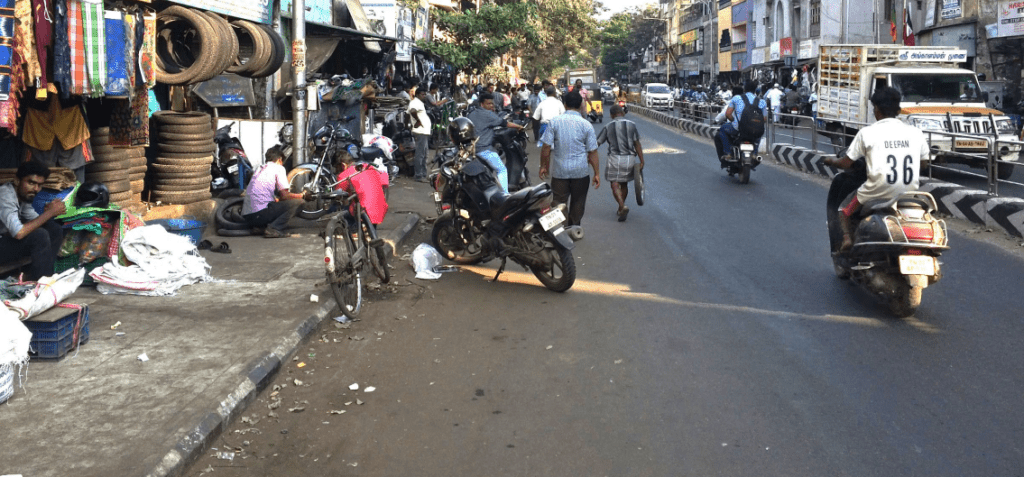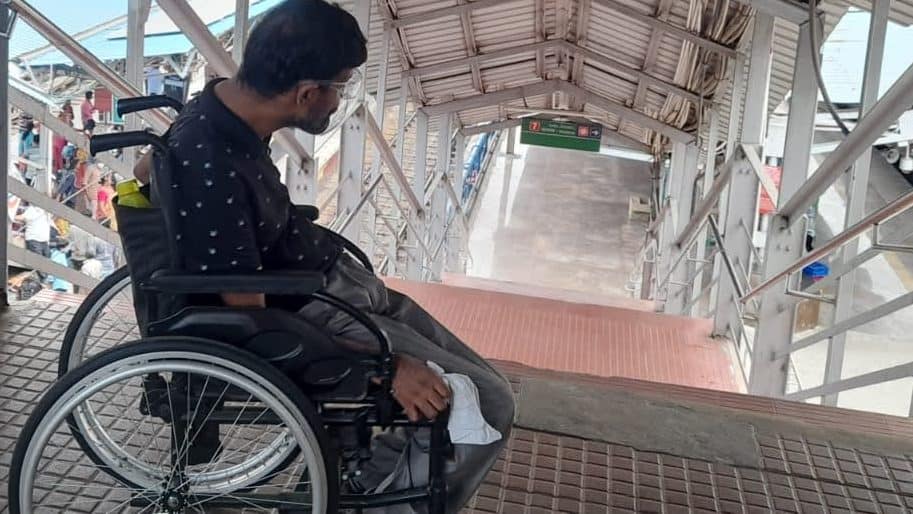“A city designed with the principles of Universal Design will ensure that all users, including people with disabilities, the elderly, children, and women, can move about the city seamlessly, at any given time, without any dependence on anyone else,” said Santhosh Loganaathan, a Chennai-based urban planner with the Institute for Transportation and Development Policy (ITDP).
If Chennai implements Universal Design perfectly, no resident will feel any inhibition while accessing urban spaces, said Santhosh. For instance, a visually impaired person and a sighted person must have the same confidence while navigating the city. “Currently, only some groups of people can participate in society,” said Smitha Sadasivan from the Disability Rights Alliance (DRA).
We look at urban spaces in Chennai through the lens of the principles of Universal Design.
Read more: 2022 could be a watershed moment for disability rights in Chennai
Urban spaces must be equally accessible to everyone
The United Nations defines Universal Design as the design of products, environments, programmes and services to be usable by all people, to the greatest extent possible, without the need for adaptation or specialised design.
“Universal design” can include devices to aid particular groups of persons with disabilities where this is needed. For instance, traffic signals must have an auditory announcement for visually impaired people to cross the roads.
Equitable use: “For instance, we aspire to design our streets with equitable distribution (not equal or biased allocation) of the limited space, among pedestrians, cyclists, public transport users and private motor vehicles. By doing so, we should accommodate everyone’s needs, but prioritise the vulnerable users and sustainable modes of transportation,” said Bala Nagendran, Senior Associate, ITDP.
There are good and bad examples of allocating the right amount of space for different road users.


“Most of the roads in Chennai are not at all friendly for people like me to walk,” said Shyamala K, a visually impaired person, who said that even if there are very neat pavements on some roads, they have been found to be broken in certain parts. Since she does not know where and when the pavement is broken, she could trip and fall.
Apart from this, some pavements are not accessible to wheelchair users in Chennai.

“In Pondy Bazaar, the bollards closer to the shops have space for wheelchairs to move. However, the other bollards are placed closer to not let vehicles on the pavements,” said Bala.
“Even if there is space between a couple of bollards in Pondy Bazaar, it is hard for a wheelchair user to navigate, because usually there are vehicles parked between them,” said Vaishnavi Jayakumar of DRA.
“If they want vehicles to not be on the pavements, then they need to increase fines from violators. Placing bollards closer on pavements does not make it accessible for people on wheelchairs,” said Smitha.
Accommodating individual preferences and abilities
Flexibility in use: Kotturpuram signal has no audio announcement. A sighted person can see red, green and amber. How can we expect a visually impaired person to know without someone else telling them?
Shyamala has the same concern. “Few signals do have audio announcements, but they will be in a junction of three or four ways, making it hard to figure out in which way the vehicles have stopped and which way I can move,” she said.
Age is also a factor to consider while introducing audio announcements in traffic signals. Kamala Vanchinathan, a septuagenarian, finds it hard crossing the Ashok Pillar road. “The audio announcement gives only ten seconds for crossing. I am old and I need more time”, she said.
“If vulnerable populations like the elderly and the disabled get an accessibility card, like in Singapore, then they can use it to get more perks. For instance, they are at a traffic signal waiting to cross, then they can tap their cards and get twice as long to cross the road than the normal crossing time,” said Santhosh.
Apart from this many local train stations are not disabled-friendly, although most of them have audio announcements regarding the arrival of trains. “There are no lifts or ramps for people with physical disabilities. The stairs are also too high. If a mother is carrying her child with disability along with bags, while climbing the stairs, she will get knee pain or backache,” said Smitha.
Although some MRTS stations like Tambaram and Egmore have escalators, elderly people are not comfortable. “I am afraid that I will fall down if I use escalators,” said Kamala.
Appropriate size and space for approach and use: Customising the size and space for people of different kinds of abilities is important while implementing universal design in Chennai.
Many disability activists have stressed reducing the heights of ticket counters in transit points like metro stations so that people sitting on wheelchairs and people with low height can also access them.
Accessible design for all
Simple and intuitive use: Irrespective of literacy or language skills, one must be able to go about in Chennai without any difficulty, according to a principle in Universal Design.
When Riddhiman Dutta came from Kolkata to Chennai for his studies in 2019, he found navigating the interior roads of Chennai hard. “The road signages were only in Tamil in interior roads near Arumbakkam, and I could not understand much,” he said, adding that Google Maps came to his aid.
Perceptible information: Visually impaired people get the shorter end of the stick because they are unable to view the design.
“A few years back, a blind man did not know he was getting inside the ladies compartment of a local train. The women asked him to get down. While he was getting down the compartment he fell and died,” said Shyamala. She recommends that there be some tactile indication of first-class, general and ladies’ compartments on the stations across which the trains could stop. This will benefit visually challenged people.
Read more: Why Chennai’s suburban rail passengers are struggling to get their voices heard
Design must minimise accidents and fatigue
Tolerance for error: According to this principle of Universal Design, in an urban space, there should be no design which would hamper the comfort and safety of a person.
At Guindy railway station, the foot over bridge is very close to the railway track, which stands in the way of the entrance to the train. When a visually impaired person tries to get in or out of the train, they may get hurt. “Now, the pillars have been painted with bright colours. But it will not help a person who is fully blind,” said Vaishnavi.
Raghuraman K is a visually impaired commuter. The above video shows his hesitation to climb onto an MRTS train in Guindy due to the obstruction caused by the foot over bridge pillar.
When Shyamala used to walk from Ashok Pillar to Vadapalani, she used to find the pavement very neat, until a point where it was broken near a church. “If I did not walk very mindfully and consciously on broken pavements, I could fall down on a busy road and get hurt,” she said.
Low physical effort: Universal design also suggests that people experience no or less fatigue while navigating a space.
Kamala said although the metro services are very comfortable, fast and efficient, the last mile connectivity is not proper. To board the next mode of transport, she has to walk from a metro station to a bus stop that is not close by, which tires her out.
However, metro stations like Guindy, St Thomas Mount and Koyambedu have different transit modes in the same area for people to shift from one mode to another.
Progress towards Universal Design in Chennai
“Some parks like the ones in Kottupuram, Nolandur and Santhome are accessible to all people”, said Smitha. Marina beach and Elliot’s beach are set to become more inclusive with permanent ramps for wheelchair users. The civic bodies teamed up with disability activists to bring about inclusive spaces.
This is an example of participatory design in urban planning where all stakeholders are consulted before designing accessible infrastructure and urban spaces.
The stakeholder engagement workshop is proposed to be held in August for the Third Masterplan, said official sources.
Apart from this, the Museum of Possibilities near Marina Beach has also been set up by the Department for the Welfare of the Differently Abled to create awareness about accessibility, assistive technology and inclusivity.
Along the lines of public transport becoming accessible to the disabled, Vaishnavi filed PILs to make Chennai metro trains and MTC buses disabled-friendly, as per the Rights of Persons with Disabilities Act of 2016. The deadline for all establishments to become disabled-friendly as per the law was June 15, 2022.
Although the MTC is set to get 242 low floor buses out of 642 buses that run on diesel, and another 100 electric low floor buses out of 500, Vaishnavi said that every bus must be made disabled-friendly, as everyone irrespective of their abilities have the right to accessibility.
On the other hand, CMRL has said that it would make most of the stations disabled-friendly at the earliest, by bringing in ramps at entry and exit points, closing rainwater drains so crutch users do not get stuck there, and other retrofits.
“A disabled-friendly transit point is not something that can be achieved by doing something only at the transit point. It needs to account for how persons with disability will reach the transit point, board the transport, and how independently they can travel as well. We need to provide universal accessible footpaths along the transit corridors and connecting destinations, apart from clear passenger information at the transit points,” said Santhosh.
Translating Universal Design theory into practice
“While a good design can inform the way people use our streets, it has its limitations too. We have to think about enforcement proactively. Currently, the city may lack the capacity for active enforcement too,” said Bala, adding that Chennai needs to strengthen enforcement, like strictly imposing fines for parking vehicles on pavements and so on.
Furthermore, the civic bodies and transport departments need to collaborate and work, said Santhosh. “An integrated or holistic approach towards universal design in Chennai is needed.”
“Sometimes the initial design itself may not be bad, but there is no regular maintenance of the infrastructure to ensure that they remain accessible and usable even as time passes,” said Shyamala.
Cooperation of the larger society is also vital for the implementation of Universal Design. “A lot of difficulties are created due to the perceptions of people,” said Ummulkhair, a lawyer with Vidya Sagar, an NGO working towards persons with disabilities.
“Private establishments also need to also follow the harmonised guidelines for an accessible and inclusive city,” said Ummulkhair. She added that if the city spaces are not made accessible, many who struggle to navigate them are stuck at home, unable to participate in any activity.
“If Universal Design is implemented in Chennai, it will ensure equality in society, and at the same time serve as a celebration of our diversity,” said Smitha.
